Master Data Management Market Size
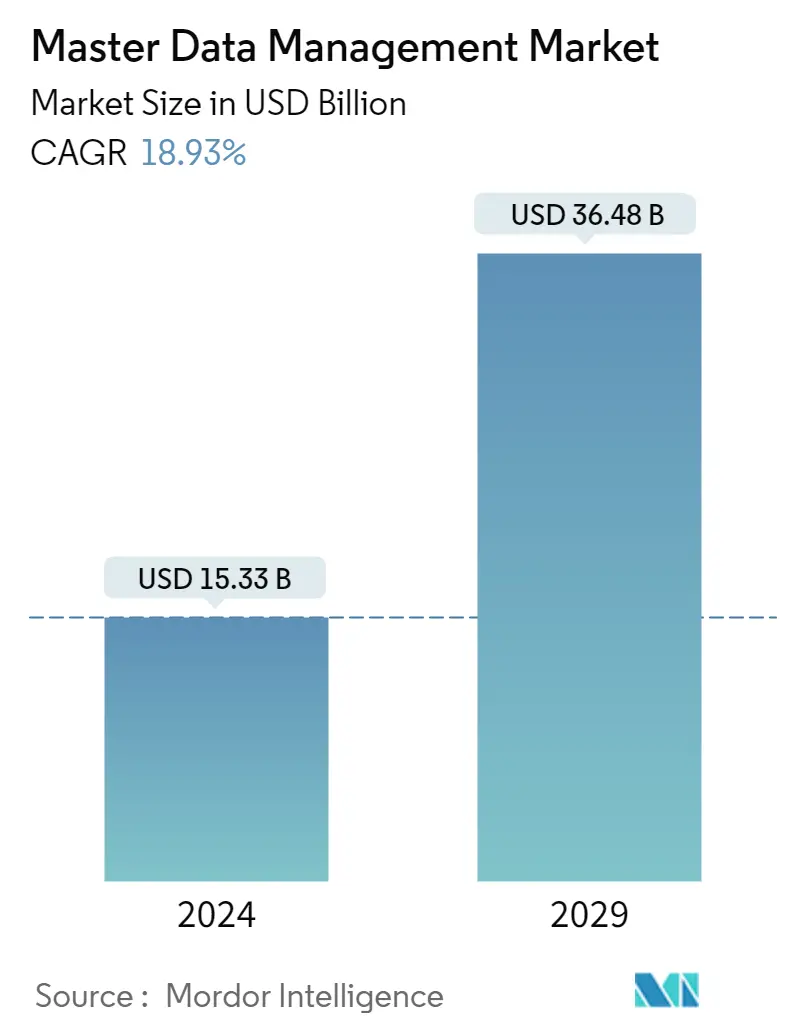
| Study Period | 2019 - 2029 |
| Market Size (2024) | USD 15.33 Billion |
| Market Size (2029) | USD 36.48 Billion |
| CAGR (2024 - 2029) | 18.93 % |
| Fastest Growing Market | Asia-Pacific |
| Largest Market | North America |
Major Players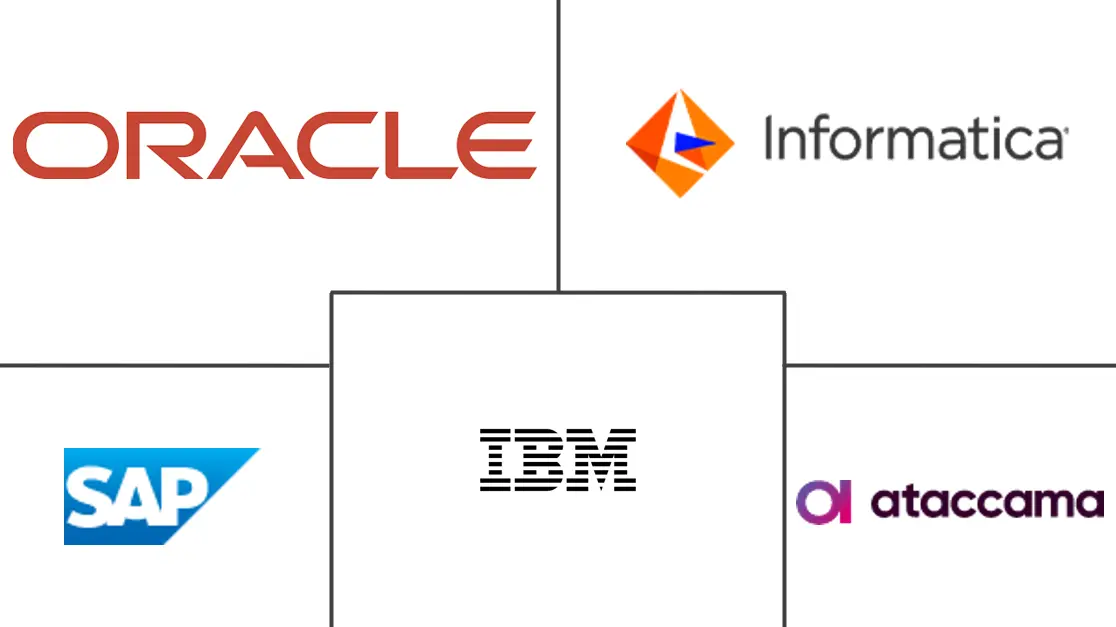
*Disclaimer: Major Players sorted in no particular order |
Need a report that reflects how COVID-19 has impacted this market and its growth?
Master Data Management Market Analysis
The Master Data Management Market size is estimated at USD 15.33 billion in 2024, and is expected to reach USD 36.48 billion by 2029, growing at a CAGR of 18.93% during the forecast period (2024-2029).
The demand for data compliance and the growing usage of master data management solutions in prominent companies to improve business operations would likely fuel revenue growth.
- To deliver information that can be relied upon for decision-making and consumer outreach, tools for master data management and data governance are essential. This is because a broader range of systems, IT specialists, and users from businesses and partner organizations create and access data.
- In recent years, organizations have become more aware of their data, which is crucial to the success or failure of an organization's most important business activities. The Internet of Things (IoT), interconnected, connected devices, cloud computing, mobility, and digitalization have all boosted data flow and volume, combined with the availability of less expensive storage, pushing organizations to preserve practically everything. Unfortunately, this strategy has caused sensitive, critical, and mission-critical data points to have varying parameters, commonly creating dark data swamps.
- The switch from segregated data environments to a consolidated master data set is now being investigated and tried by many businesses. The purpose of such master data initiatives, also known as master data management (MDM) projects, is to generate a golden copy of crucial company data for consumption and to discover, validate, and address data errors near the source as feasible. A successful MDM program enables data consistency, completeness, and correctness. However, installing an MDM program can only guarantee success if business-supported data management initiatives are implemented concurrently.
- The market is growing due to recent innovations in machine learning (ML), big data, and artificial intelligence (AI). In addition to offering access to enormous datasets, this technology offers new technological possibilities for data processing and storage. As new technologies' capacity for handling data from several domains and perspectives has increased, customers have a wide range of expectations. The most frequent request has been to combine master data management systems with big data, analytics, and business intelligence technologies.
- However, implementation, data security, and privacy issues constrain market revenue. Due to strict laws and extensive business requirements, MDM implementation might be challenging. Furthermore, firms are progressively integrating technologies, which makes them prone to security flaws and assaults. Users resist MDM solutions because they are concerned about losing critical personal data. These issues are inhibiting MDM solution adoption and limiting the market's revenue growth.
Master Data Management Market Trends
Cloud MDM Segment to Hold a Significant Share
- Analyzing new technologies and approaches for acquiring, storing, and utilizing master data is becoming vital as master data management (MDM) becomes essential for fostering company success. The next generation of MDM systems is driven by AI/ML, cloud, federated architectures, inter-enterprise sharing, global deployment, data platform solutions, and other contemporary MDM features.
- Enterprise sectors have used MDM technologies on the cloud for speed and flexibility since vendors and customers are dispersed worldwide and communicate virtually. Businesses will customize their MDM cloud services, while those onshore will result in a stronger focus on master data integration and data quality to and from cloud sources.
- As more apps and data migrate to the cloud, data professionals can manage more complicated amounts of data across several clouds, inside one cloud, and on-premises sources. To enable these various topologies, multi-cloud and inter-cloud data management is essential.
- Cloud-based services are becoming more widely used for MDM (as well as other essential corporate applications). A cloud-native solution, such as cloud MDM, will probably offer advantages over on-premise solutions concerning integration with cloud-sourced data and apps as the center of gravity for data continues to move beyond the firewall.
- According to Eurostat statistics on enterprise use of cloud services in 2021, over 94% of all businesses in the European Union have implemented cloud software-as-a-service, which includes master data management solutions. Every business trend indicates that a cloud-native MDM platform is required. In addition to the well-known benefit of requiring less work to get up and running, the flexible microservice design offers greater advantages for simple updates, smooth scalability, and rapid portability.
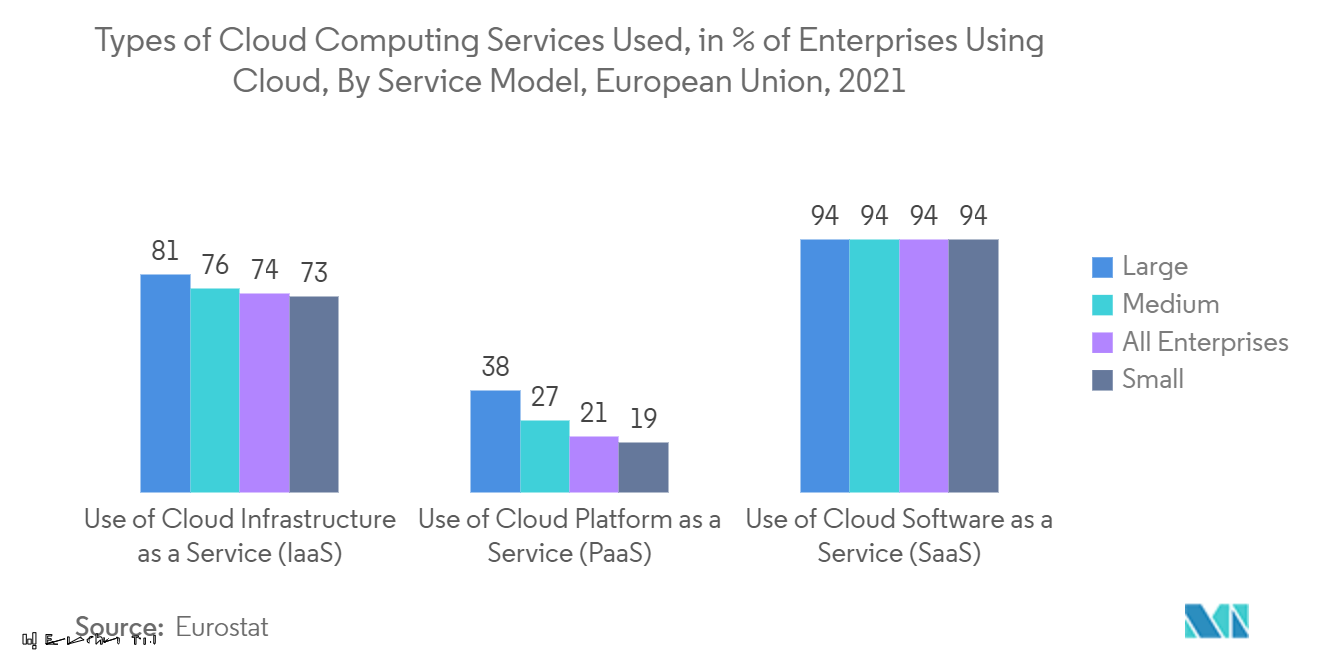
North America to Hold Major Market Share
- The master data management industry is estimated to have the largest market share in North America. The expanding use of technology in the area is one of the main reasons promoting the growth of the MDM market in North America. The expansion of MDM players across regions, such as IBM, Oracle, and Informatica Inc., is anticipated to drive market expansion further.
- On the other hand, the growth of R&D spending by significant regional economies is helping the development of new technologies in the North American master data management market.
- For instance, in June 2022, Ataccama, a unified data management and governance solutions provider, secured USD 150 million in a growth capital investment round, money that will be used to finance the company's efforts to develop new products and expand its market presence.
- Organizations working in specific industries, including banking and healthcare, are required to adopt MDM because of the strict data protection and security rules in the United States. The increasing desire to enhance operational effectiveness and lessen data redundancy also drives the market.
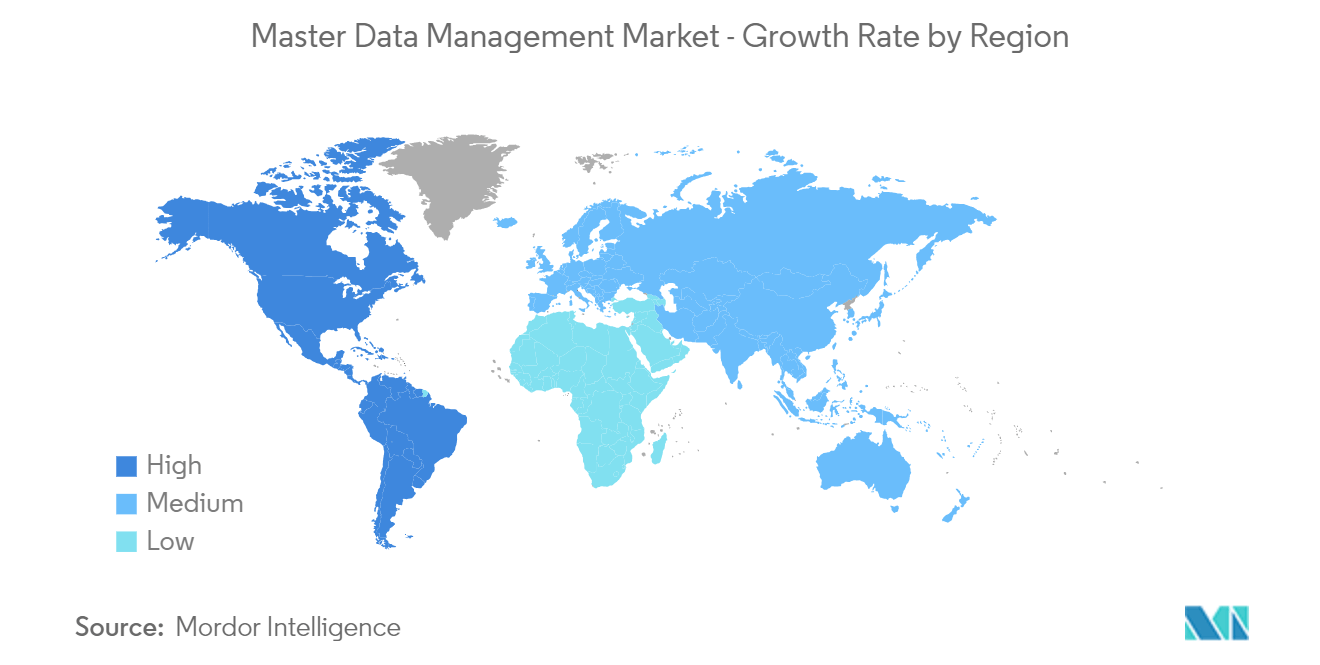
Master Data Management Industry Overview
The master data management market is highly fragmented and has several significant players. Only some key companies currently hold a large portion of the market, such as IBM, Oracle, Informatica Inc., SAP SE, and Ataccama. The players in the market are growing their consumer bases internationally to raise their market share and profitability.
- October 2022 - Ataccama, a top provider of unified data management platforms, announced the early distribution of the upcoming significant update to its Ataccama ONE platform. With this version, Ataccama will introduce new features that support its objective of giving businesses worldwide end-to-end data management and allowing data democratization. The platform upgrade places Ataccama at the forefront of a growing industry agreement that contemporary data governance programs must converge data governance capabilities in ways that single-purpose technologies cannot.
- February 2022 - IBM announced that it had acquired Neudesic, a US cloud services consultant focused on the Microsoft Azure platform and multi-cloud expertise. The portfolio of hybrid multi-cloud services offered by IBM will be significantly increased due to this purchase, further advancing the company's hybrid cloud and AI strategy.
Master Data Management Market Leaders
IBM
Oracle
Informatica Inc.
SAP SE
Ataccama
*Disclaimer: Major Players sorted in no particular order
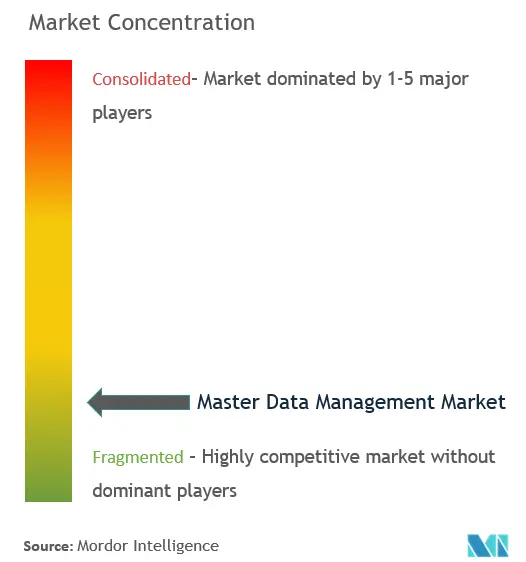
Master Data Management Market News
- May 2022 - Informatica and Oracle announced a strategic relationship that will enable Oracle Cloud Infrastructure (OCI) to use Informatica's product data integration and governance technologies. Additionally, Oracle has designated Informatica as a preferred partner for data governance and enterprise cloud data connectivity for lakehouse and data warehouse solutions on OCI. Oracle and Informatica have joined forces through this project to connect their products: Oracle Object Storage, Oracle Exadata Cloud Customer, Oracle Autonomous Database, and Oracle Exadata Database Service. These services will be made accessible in the Oracle Cloud Marketplace by Informatica and Oracle.
- March 2022 - Cloud-native Intelligent Multi-domain Master Data Management (MDM), launched by Informatica, an enterprise cloud data management company, will give clients trustworthy views of business-critical master data across all domains and assets, enhancing every function with intelligent data.
Master Data Management Market Report - Table of Contents
1. INTRODUCTION
1.1 Study Deliverables
1.2 Study Assumptions
1.3 Scope of the Study
2. RESEARCH METHODOLOGY
3. EXECUTIVE SUMMARY
4. MARKET INSIGHTS
4.1 Market Overview
4.2 Industry Attractiveness - Porter's Five Forces Analysis
4.2.1 Bargaining Power of Suppliers
4.2.2 Bargaining Power of Buyers/Consumers
4.2.3 Threat of New Entrants
4.2.4 Threat of Substitute Products
4.2.5 Intensity of Competitive Rivalry
4.3 Assessment of Impact of COVID-19 on the Market
5. MARKET DYNAMICS
5.1 Market Drivers
5.1.1 Increasing Demand for Verification and Compliance
5.1.2 Growing Usage of Data Quality Tools for Data Management
5.2 Market Restraints
5.2.1 Expensive Integration and Maintenance activities
5.2.2 Concerns on Data Security and Privacy
5.2.3 Stringent Data Regulations Imposed in Various Regions
6. MARKET SEGMENTATION
6.1 By Component
6.1.1 Software
6.1.2 Service
6.2 By Deployment Model
6.2.1 On-premise
6.2.2 Cloud
6.3 By Enterprise Size
6.3.1 Large Enterprises
6.3.2 Small and Medium Enterprises
6.4 By Application
6.4.1 Supplier
6.4.2 Product
6.4.3 Customer
6.4.4 Other Applications
6.5 By Industry Vertical
6.5.1 IT and Telecommunication
6.5.2 BFSI
6.5.3 Healthcare
6.5.4 Government
6.5.5 Retail
6.5.6 Manufacturing
6.5.7 Education
6.5.8 Other Industry Verticals
6.6 By Geography
6.6.1 North America
6.6.2 Europe
6.6.3 Asia-Pacific
6.6.4 Middle East and Africa
6.6.5 Rest of the World
7. COMPETITIVE LANDSCAPE
7.1 Company Profiles
7.1.1 IBM
7.1.2 Oracle
7.1.3 Informatica Inc.
7.1.4 SAP SE
7.1.5 Ataccama
7.1.6 SAS Institute Inc.
7.1.7 TIBCO Software Inc.
7.1.8 Teradata Corporation
7.1.9 Syndigo LLC
7.1.10 Profisee
- *List Not Exhaustive
8. INVESTMENT ANALYSIS
9. FUTURE OF THE MARKET
Master Data Management Industry Segmentation
To maintain the consistency, correctness, stewardship, semantic consistency, and accountability of the enterprise's official shared master data assets, business and information technology collaborate through the discipline of master data management (MDM), which is facilitated by technology.
The master data management market is segmented by component (software, service), by deployment model (on-premise, cloud), by enterprise size (large enterprises, small and medium enterprises), by application (supplier, product, customer), by industry vertical (IT and telecommunication, BFSI, healthcare, government, retail, manufacturing, education), and geography. The market sizes and forecasts are provided in terms of value in USD million for all the above segments.
| By Component | |
| Software | |
| Service |
| By Deployment Model | |
| On-premise | |
| Cloud |
| By Enterprise Size | |
| Large Enterprises | |
| Small and Medium Enterprises |
| By Application | |
| Supplier | |
| Product | |
| Customer | |
| Other Applications |
| By Industry Vertical | |
| IT and Telecommunication | |
| BFSI | |
| Healthcare | |
| Government | |
| Retail | |
| Manufacturing | |
| Education | |
| Other Industry Verticals |
| By Geography | |
| North America | |
| Europe | |
| Asia-Pacific | |
| Middle East and Africa | |
| Rest of the World |
Master Data Management Market Research FAQs
How big is the Master Data Management Market?
The Master Data Management Market size is expected to reach USD 15.33 billion in 2024 and grow at a CAGR of 18.93% to reach USD 36.48 billion by 2029.
What is the current Master Data Management Market size?
In 2024, the Master Data Management Market size is expected to reach USD 15.33 billion.
Who are the key players in Master Data Management Market?
IBM, Oracle, Informatica Inc., SAP SE and Ataccama are the major companies operating in the Master Data Management Market.
Which is the fastest growing region in Master Data Management Market?
Asia-Pacific is estimated to grow at the highest CAGR over the forecast period (2024-2029).
Which region has the biggest share in Master Data Management Market?
In 2024, the North America accounts for the largest market share in Master Data Management Market.
What years does this Master Data Management Market cover, and what was the market size in 2023?
In 2023, the Master Data Management Market size was estimated at USD 12.89 billion. The report covers the Master Data Management Market historical market size for years: 2019, 2020, 2021, 2022 and 2023. The report also forecasts the Master Data Management Market size for years: 2024, 2025, 2026, 2027, 2028 and 2029.
What are the biggest challenges faced by companies when implementing Master Data Management (MDM)?
The biggest challenges faced by companies when implementing Master Data Management (MDM) are a) Data quality issues b) System integration complexities c) User adoption challenges
Master Data Management Industry Report
The global master data management (MDM) market is witnessing remarkable growth, fueled by the escalating complexity and volume of data across various sectors. As organizations grapple with massive data generation, the demand for master data management solutions, which ensure a single, accurate, and consistent version of master data, is surging. These solutions are pivotal for enhancing data quality, regulatory compliance, and decision-making, by integrating, cleansing, and synchronizing critical data from diverse sources. The market, segmented by components, deployment models, enterprise size, and industries like BFSI, IT, telecom, healthcare, retail, and manufacturing, is seeing a notable shift towards cloud-based MDM solutions for their scalability and cost-efficiency. The integration of AI and machine learning is further expanding opportunities for businesses to optimize their data assets. Despite data security and implementation complexities, the master data management market size is set to expand, driven by the imperative for efficient data management in a data-centric world. For detailed insights, Mordor Intelligence™ offers an in-depth analysis, including market share, size, revenue growth rate, and a forecast outlook, available as a free report PDF download, essential for any master data management company looking to lead in this dynamic market.
